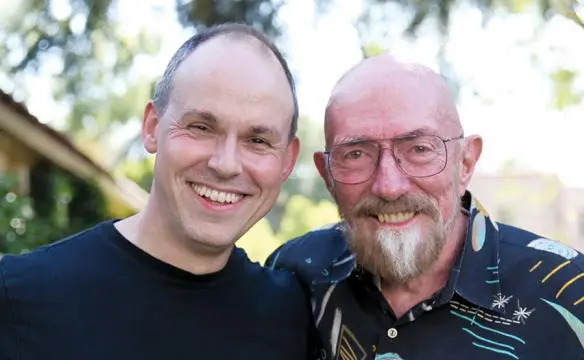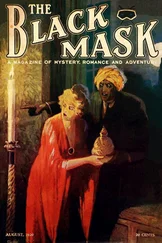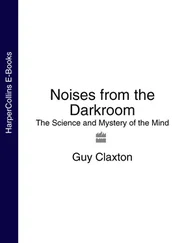Chris is down to earth, fascinating to talk with, and has a great sense of wry humor. He reminds me of another friend of mine, Gordon Moore, the founder of Intel: Both, at the pinnacle of their fields, completely unpretentious. Both driving old cars, preferring them to their other, more luxurious cars. Both making me feel comfortable and, introvert that I am, that’s not easy.
Paul Franklin, Oliver James, Eugénie von Tunzelmann: The Visual-Effects Team
One day in mid-May 2013 Chris phoned me. He wanted to send a guy named Paul Franklin over to my home to discuss the computer graphics for Interstellar . Paul came the next day, and we spent a delightful two hours brainstorming in my home office. He was modest in demeanor, by contrast with Chris’s forcefulness. He was brilliant. He showed a deep knowledge of the relevant science, despite having majored in the arts in college.
As Paul was leaving, I asked him which graphics company he was thinking of using for the visual effects. “Mine,” he responded, mildly. “And what company is that?” I asked, naively. “Double Negative. We have 1000 employees in London and 200 in Singapore.”
After Paul departed I Googled him and discovered that not only had he cofounded Double Negative, he had also won an Academy Award for the visual effects in Chris’s movie Inception . “It’s time I get educated about this movie business,” I murmured to myself.
In a video conference a few weeks later, Paul introduced me to the London-based leaders of his Interstellar visual-effects team. Most relevant to me were Oliver James, the chief scientist who would write computer code underlying the visual effects; and Eugénie von Tunzelmann, who led the artistic team that would take Oliver’s computer code and add extensive artistic twists to produce compelling images for the movie.

Fig. 1.3. Paul Franklin and Kip.
Oliver and Eugénie were the first people with physics training that I had met on Interstellar . Oliver has a degree in optics and atomic physics, and knows the technical details of Einstein’s special relativity. Eugénie is an engineer, trained at Oxford, with a focus on data engineering and computer science. They speak my language.
We quickly developed a great working relationship. For several months, I struggled near full time, formulating equations for images of the universe near black holes and wormholes (Chapters 8 and 15). I tested my equations using low-resolution, user-friendly computer software called Mathematica, and then sent the equations and Mathematica code to Oliver. He devoured them, converted them into sophisticated computer code that could generate the ultra-high-quality IMAX images needed for Interstellar , and then passed them on to Eugénie and her team. It was a joy working with them.

Fig. 1.4. Eugénie von Tunzelmann, Kip, and Oliver James.
And the end product, the visualizations in Interstellar , are amazing! And scientifically accurate.
You cannot imagine how ecstatic I was when Oliver sent me his initial film clips. For the first time ever—and before any other scientist—I saw in ultrahigh definition what a fast-spinning black hole looks like. What it does, visually, to its environment.
Matthew McConaughey, Anne Hathaway, Michael Caine, Jessica Chastain
On July 18, two weeks before filming was to begin, I received an e-mail from Matthew McConaughey, who plays Cooper: “per Interstellar,” he wrote, “I’d like to ask you some questions and… If you are around L.A. area, in person is preferable. Lemme know please, thanks, in process, mcConaughey.”
We met six days later, in a suite at L’Hermitage, a boutique hotel in Beverly Hills. He was ensconced there, struggling to wrap his head around the role of Cooper and the science of Interstellar .
When I arrived, he opened the door dressed in shorts and a tank top, barefooted and thin from having just filmed Dallas Buyers’ Club (for which he later won the Oscar for best actor). He asked if he could call me “Kip”; I said of course and asked what I should call him. “Anything but Matt; I hate Matt.” “Matthew.” “McConaughey.” “Hey you.” “Whatever you like.” I chose “McConaughey” as it trips off the tongue so nicely, and there are too many Matthews in my life.
McConaughey had removed all the furniture from the suite’s huge living/dining room, except an L-shaped couch and a coffee table. Strewn over the floor and table were 12-by-18-inch sheets of paper, each covered with notes dealing with a particular topic, written in random directions, squiwampus. We sat on the couch. He would pick up a sheet, browse it, and ask a question. The question was usually deep, and triggered a long discussion during which he would write notes on the sheet.
Often the discussion would take off in unexpected directions, with the sheet forgotten. It was one of the most interesting and enjoyable conversations I’ve had in a long time! We wandered from the laws of physics, especially quantum physics, to religion and mysticism, to the science of Interstellar , to our families and especially our children, to our philosophies of life, to how we each get inspirations, how our minds work, how we make discoveries. I left, two hours later, in a state of euphoria.
Later I told Lynda about our meeting. “Of course,” she responded. She could have told me what to expect; Interstellar is her third film with McConaughey. I’m glad she didn’t tell me. It was a joy to discover for myself.
The next e-mail, a few weeks later, was from Anne Hathaway, who plays Amelia Brand. “Hi Kip! I hope this e-mail finds you well…. Emma Thomas passed along your e-mail in case I had any questions. Well, the subject matter is pretty dense so I have a few!… would we be able to chat? Thank you very much, Annie.”
We talked by phone, as our schedules couldn’t be meshed for an in-person meeting. She described herself as a bit of a physics geek, and said that her character, Brand, is expected to know the physics cold—and then she launched into a series of surprisingly technical physics questions: What is the relationship of time to gravity? Why do we think there might be higher dimensions? What is the current status of research on quantum gravity? Are there any experimental tests of quantum gravity?… Only at the end did she let us wander off subject, to music, in fact. She played trumpet in high school; I played sax and clarinet.
During the filming of Interstellar , I was on set very, very little. I was not needed. But one morning Emma Thomas toured me through the Endurance set—a full-scale mockup of the Endurance spacecraft’s command and navigation pod, in Stage 30 at Sony Studios.
It was tremendously impressive: 44 feet long, 26 feet wide, 16 feet high, suspended in midair; able to shift from horizontal to nearly vertical; exquisite in detail. It blew me away, and piqued my curiosity.
“Emma, why build these enormous, complex sets, when the same thing could be done with computer graphics?” “It’s not clear which would be cheaper,” she responded. “And computer graphics can’t yet produce the compelling visual details of a real set.” Wherever possible, she and Chris use real sets and real practical effects, except for things that can’t actually be shot that way, like the black hole Gargantua.
Читать дальше














